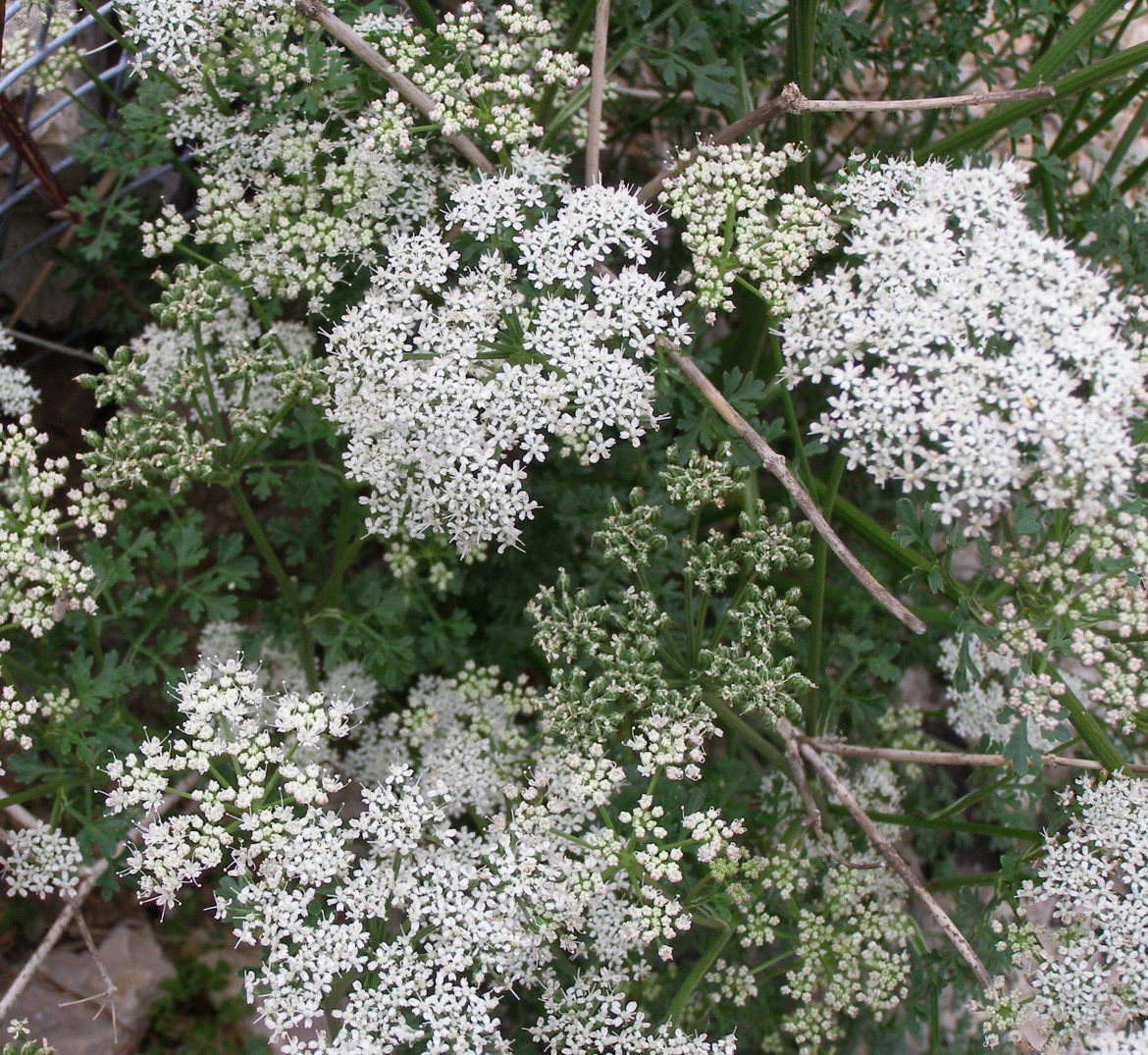Where is it found ?
Endemic to the Balearic Islands, this species occurs in northern Majorca on the Tramuntana mountain range at 1300-1400 m a.s.l. It grows on limestone cliffs in shaded, slightly moist rock crevices and on rocky ridges (habitats 6.2: Inland cliffs. Rock pavements and outcrops and 6.4: Miscellaneous inland habitats with very sparse or no vegetation) with ca. 400 individuals spread over an area of less than 0.1 km2.
How to recognize it ?
L. huteri is a perennial herb growing up to 100 cm in height, which forms tufts with sprawling roots and has a peculiar smell. Its stem is stiff, grooved and shiny and deeply incised leaves grow from the base of the plant. The flowering period occurs from June to August when large, dense bunches of white flowers in umbrella-shaped inflorescences appear. The petals have a dark grey line on their lower side. The seeds are furrowed and flattened sideways.
Interesting facts
The biology of this plant is not well known. The aboveground parts disappear during winter and grow up from the base between April and June. The plants seem to perform abundant flowering only after several years of adequate rainfall. This initial favourable period is probably necessary for the storage of energy needed to perform flowering. This plant reproduces from seed only.
The reproductive plants often die after fructification but it is not a general rule, as some are able to live further on.
The populations show a very low genetic variability; those found on the northern slope of the mountain are the most diverse with three different genotypes.
Why is it threatened ?
This species has been categorized CR (Critically Endangered) according to IUCN Red List Criteria B1ac(iv)+2ac(iv). This means that it only occurs in one locality over a very small area (0.1 km2), and that the total number of individuals is small (408 individuals in 2015, 12 of which were reproductive) although a positive demographic trend has been recorded. In the past a strong fluctuation of mature individuals was mainly due to goat grazing. Nowadays the strong fluctuation keeps going on due to the small amount of plants which become reproductive year by year after the reinforcement activities.
As there are no more suitable places to grow the plant except where population reinforcements have already been made, the main threat is low habitat availability (threat 12.1: Other threats), the impact of extreme dry years (threat 11.2: Drought). Grazing was the most important threat before the population was protected by metal fences, and still represents a potential threat, also because the number of wild goats has recently increased and the state of the protection fences is not regularly monitored (threat 8.1.2: Invasive non-native/alien species - Named species). Additionally, field observations pointed out a very low reproductive performance, with low number of umbels and fruits, low numbers of viable seeds and low germination rates near mother plants (threat 12.1: Other threats).
What has been done to protect it ?
Legally: L. huteri is classified as in danger of extinction, i.e. the highest threat level according to the Decree 75/2005, (Balearic Catalogue of Endangered Species, Special Biological Protection Areas) and the Advisory Council of Flora and Fauna of the Balearic Islands.
In situ: The extinction risk for the species is high despite the area being accessible only under military permission and several management actions having been carried out during the last years that have helped to significantly increase the population (to reach more than 600% compared to the 2007 census when only 64 individuals, and only 3 reproductive plants, were counted). To solve the lack of available habitats, two ad hoc activities have been carried out: individuals have been planted in any other suitable area where there is soil, and native ruderal species competing for space have been eradicated.
Physical protection measures (i.e. fencing), population reinforcement and further field surveys were considered being the most urgent actions and carried out in order to increase the performance of the current conservation measures. These actions were covered by a Recover Plan which was approved in 2008 by the Government of the Balearic Islands.
The whole population falls within the Natura 2000 site ES5310027 ’Cimals de la Serra’.
Ex situ: Seeds of L. huteri are stored in the germplasm banks of Barcelona and Sóller Botanical Gardens, and some plants are also cultivated in latter.
What conservation actions are needed ?
A significant increase in number of individuals will depend on the establishment of seedlings and the consequent spread of mature individuals in more accessible or not fenced areas. Hence, ongoing conservation actions may result to be effective in a long-term perspective only along with a strong reduction of wild herbivore grazing pressure.
Scientific coordination
Sr. Gabriel Bibiloni, University of the Balearic Islands.
Sr. Pere Fraga i Gibernau, Island Council of Menorca.
Dr. Eva Moragues, Government of the Balearic Islands.
Dr. Mauricio Mus, University of the Balearic Islands.
Dr. Juan Rita, University of the Balearic Islands.
Dr. Llorenç Sàez, Autonomous University of Barcelona.
Photos
Dr. Eva Moragues, Government of the Balearic Islands.
Josep Lluis Gradaille, Jardí Botànic de Sóller.

